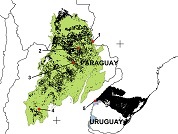Genetic diversity and fragmentation of Aspidosperma quebracho-blanco (Apocynaceae) natural habitats, conservation issues in Chaco forest and savanna biomes
DOI:
https://doi.org/10.14522/darwiniana.2021.91.932Keywords:
Conservation unit, deforestation, dry forests, espinilho fields, ISSRAbstract
The present study analyses the first data on genetic diversity of A. quebracho-blanco with the fragmentation of its natural habitat, supporting conservation strategies such as the definition of priority areas for conservation. DNA was extracted from 25 individuals of five populations of A. quebracho-blanco from Argentina, Paraguay, and Brazil. Six ISSR primers were used to characterize the genetic diversity and structure of this species. The genotypes were grouped according to a distance matrix, considering the genetic diversity indices of Nei (He), Shannon (H’), polymorphic information content (PIC), and heterozygosis (H). The populations showed an average genetic diversity that ranged from 0.09 to 0.15 for the Shannon index and from 0.19 to 0.31 for the Nei index; the Mantel test was not significant (r2 = 0.25, P = 0.106). The results obteined for the sampled populations reveal that conservation units are indispensable for conserving the species genetic resources. In addition, it would be essential to construct a germplasm bank for the Cordoba (Argentina) population, which is a population with high genetic diversity in a region of lower fragmentation compared to other regions evaluated, to ensure the conservation of A. quebracho-blanco.

Downloads
Published
How to Cite
Issue
Section
License

Starting on 2012, Darwiniana Nueva Serie uses Licencia Creative Commons Atribución-NoComercial 2.5 Argentina .





